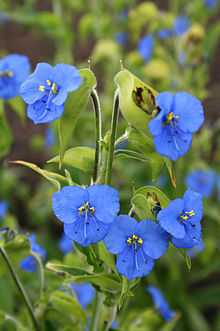Commelina tuberosa
| Commelina tuberosa | |
|---|---|
 | |
| Scientific classification | |
| Kingdom: | Plantae |
| (unranked): | Angiosperms |
| (unranked): | Monocots |
| (unranked): | Commelinids |
| Order: | Commelinales |
| Family: | Commelinaceae |
| Subfamily: | Commelinoideae |
| Tribe: | Commelineae |
| Genus: | Commelina |
| Species: | C. tuberosa |
| Binomial name | |
| Commelina tuberosa L., 1753[1] | |
Commelina tuberosa is an herbaceous plant in the dayflower family native to Mexico but grown worldwide as an ornamental plant.[2][3][4] It is characterized by its purple-splotched spathes with free margins, its bright blue petals of equal size, its tuberous roots, and its four to ten flowered lower cymes. In the wild, it is encountered in moist fields, open forests, or pine-oak forests.[5] The species is sometimes considered to include the species Commelina coelestis, Commelina dianthifolia, and Commelina elliptica, such as in the Flora Mesoamericana.[5] When these are treated as separate, they are often referred to as the "Commelina tuberosa complex". Horticulturally, the species are often treated as separate entities because of their differing habits and leaf shapes. In this sense, Commelina tuberosa is a low-growing plant with long narrow leaves.[6]
External links
References
- ↑ Linnaeus (1753). "Commelina". Species Plantarum (in Latin). pp. 40–42.
- ↑ Kew World Checklist of Selected Plant Families
- ↑ Huxley, A. (1992). The New RHS Dictionary of Gardening. MacMillan Press. ISBN 0-333-47494-5.
- ↑ Pink, A. (2004). Gardening for the Million. Project Gutenberg Literary Archive Foundation.
- ↑ 5.0 5.1 Hunt, D. R. (1994), "Commelinaceae", in Davidse, Gerrit; Sousa Sánchez, Mario; Chater, Arthur Oliver, Flora Mesoamericana 6, Universidad Nacional Autónoma de México, p. 173
- ↑ Cullen, James; Knees, Sabina G.; Cubey, H. Suzanne (2011), The European Garden Flora, Flowering Plants 1 (2 ed.), Cambridge University Press, p. 319, ISBN 978-0-521-76167-3